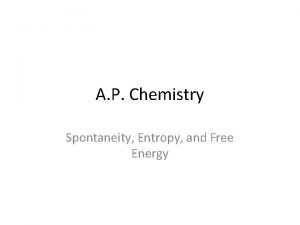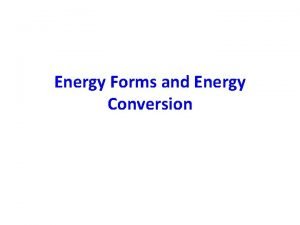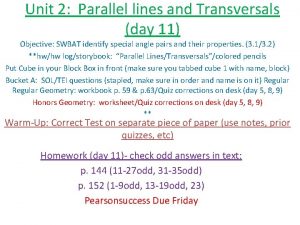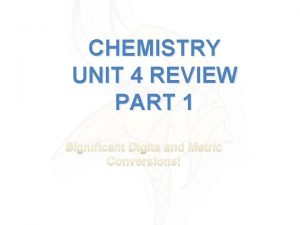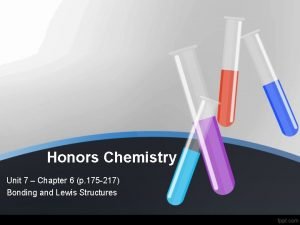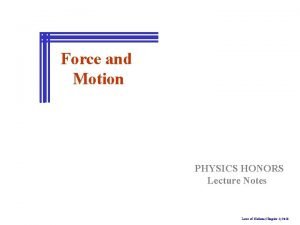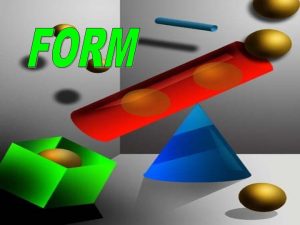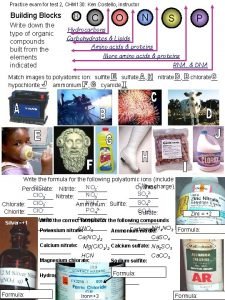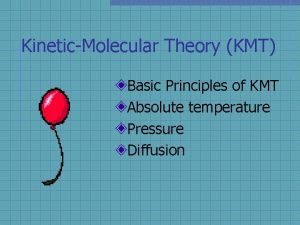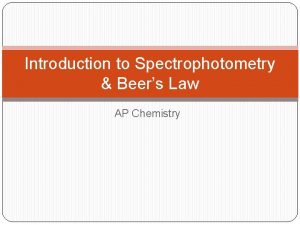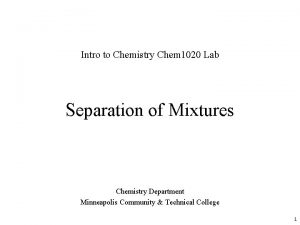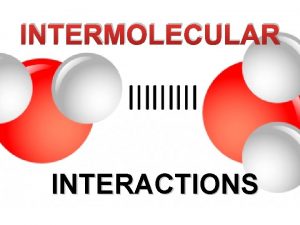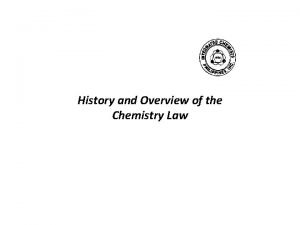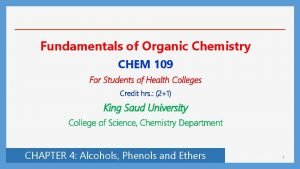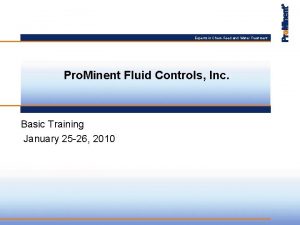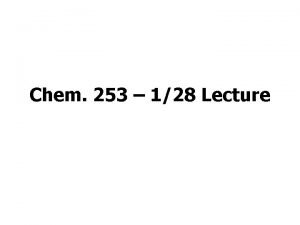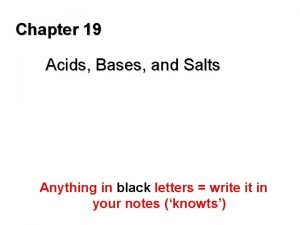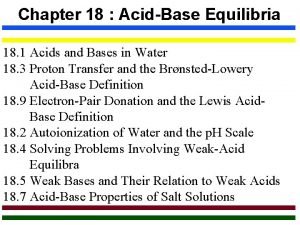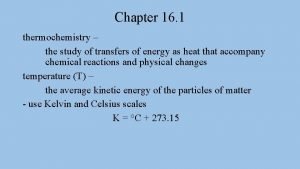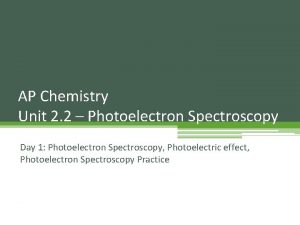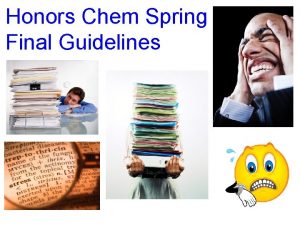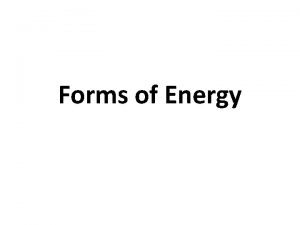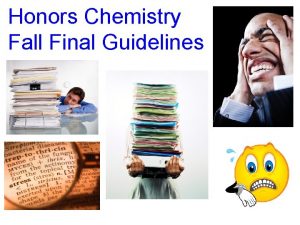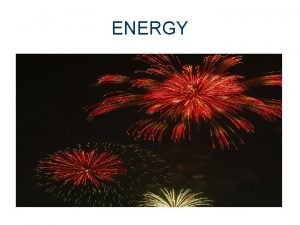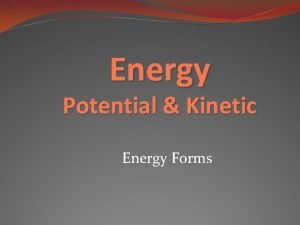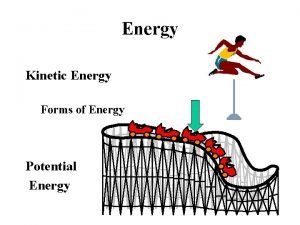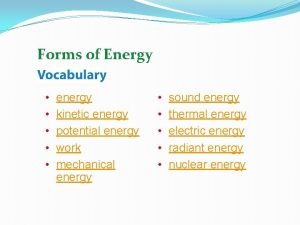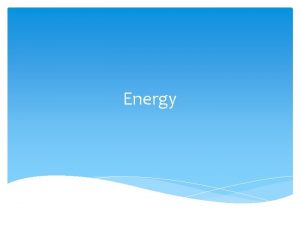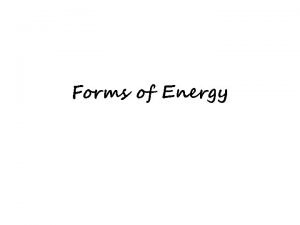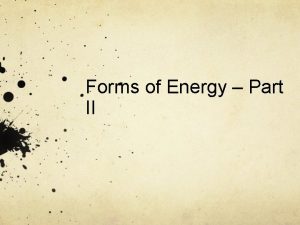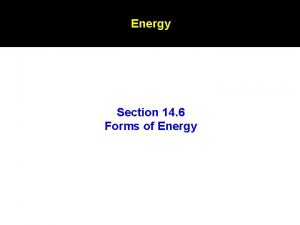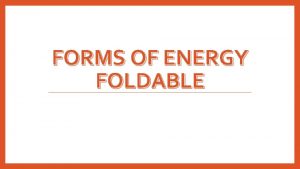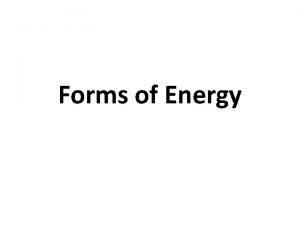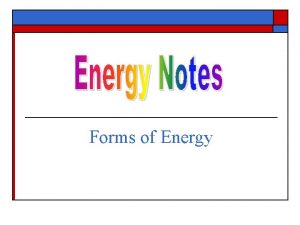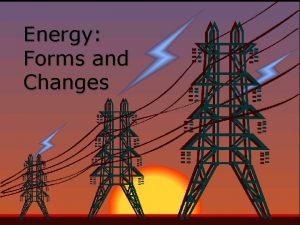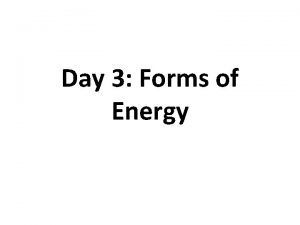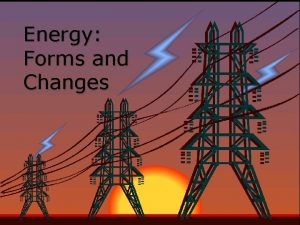Energy Chem Honors Chapter 10 7 Forms of


































































- Slides: 66

Energy Chem Honors Chapter 10

7 Forms of Energy Sound- from vibration of sound waves Chemical- fuel, gas, wood, battery Radiant (light)- electromagnetic energy Electrical energy- electrons moving among atoms - as in the conductive wire of an electrical cord • Atomic- nuclear (from nucleus of an atom) • Mechanical- walk, run • Thermal- heat • •


What is energy? • Energy is the ability to do work or produce heat • Two types: –Potential energy –Kinetic energy

• Potential energy- energy due to position or composition • Ex: –water behind a dam –Attractive and repulsive forces

• Kinetic energy – is energy due to the motion of the object and depends on the mass (m) and velocity (v) • KE = ½ 2 mv

Law of Conservation of Energy • States that energy can be converted from one form to another but can never be created or destroyed

Energy form going in- electrical Energy form going out- heat and light

Chemical energy stored in bonds of gasoline molecules converted to mechanical and heat energy through combustion

Electrical energy converted to mechanical energy

Hoover Dam- hydropower plant converts mechanical energy (flowing water) to electromagnetic, which is transported to homes, and then converted back into mechanical energy in a blender

• Work- force acting over a distance

State Function • Property of a system that does not depend on the pathway to its present state. – Ex: Displacement is a state function: I send 2 students to the cafeteria…the cafeteria is a specific distance from here…. even though the 2 students take different routes to get to the cafeteria, they bith end up the same distance away from this room.

• Energy is a state function : • Work and heat are not state functions:

Temperature and Heat • What is the difference between warm water and cold water?

• Thermal energy: random motions of components of an object • Temperature: measures the random motions of the components of a substance (thermal energy) • Heat: flow of energy due to a temperature difference

System and Surroundings • System- part of the universe that we are focusing our attention on • Surroundings- everything else in the universe

• Exothermic process – a process that results in the evolution of heat- energy flows out of the system • Endothermic process- a process that absorbs energy from the surroundings- energy flows into the system

Exothermic or endothermic? 1. Your hand gets cold when you touch ice 2. ice melts when you touch it 3. Ice cream melts 4. Propane is burning in a propane torch. 5. Water drops on your skin evaporate after swimming • 6. Two chemicals mixing in a beaker give off heat • • •

• • • Exothermic Endothermic Exothermic Endthermic exothermic

• Energy from an exothermic reaction comes from the difference in potential energy between the products and reactants • Which has lower energy, the reactants or products?

Burning match • -Total energy is conserved • -exothermic so energy flows from system to surroundings • - So the energy gained by the surroundings must be equal to the energy lost by the system

Burning match cont. • The potential energy lost from the burned match came from the stored energy in the bonds of the reactants • In any exothermic reaction some of the potential energy stored in the chemical bonds is converted to thermal energywhich is random kinetic energy- as heat

Thermodynamics • Thermodynamics- study of energy • Law of Conservation of energy is also known as • THE FIRST LAW OF THERMODYNAMICS!! – The energy of the universe is constant.

1 st Law- A Quantitative application • We can use the first law to analyze energy changes in chemical systems • Internal energy (E) of a system is the sum of all of the PE (potential energy) and KE (kinetic energy) of a system E = PE + KE

ΔE > 0 ΔE < 0 Internal Energy, E H 2 (g) , O 2 (g) H 2 O (l)

• The internal energy of a system can be changed by a flow of work or heat or both so mathematically we have ΔE = q + w Δ = change in q = heat added or liberated by the system w = work done on the system

Thermodynamic quantities have –Number – indicates the magnitude of the change –Sign (+ or -) – indicates the direction of the flow from the SYSTEM’s point of view

q and w • When heat is added to a system, or work is done on a system, the internal energy increases so – When heat is transferred from the surroundings to the system q is positive – When work is done on a system by the surroundings w is positive

q and w • Work and heat created by the system transferred to the surroundings lowers the internal energy of the system – When work is done by the system on the surroundings, w is negative – When heat flows from the system to the surroundings, q is negative

• In an exothermic process, what is the sign of q? • In an endothermic process, what is the sign of q?

Measuring Energy Changes • Common units of energy change – Calorie – amount of energy (heat) required to raise the temperature of one gram of water one degree Celsius – Joule – in terms of a calorie • 1 calorie = 4. 184 J

Measuring Energy Changes cont. • Express 60. 1 cal of energy as Joules • • 60. 1 cal x 4. 184 J = 251 J 1 cal

Measuring Energy Changes Cont. • The energy (heat) required to change the temperature of a substance depends on – The amount of substance being heated (grams) – The temperature change – Identity of the substance

Measuring Energy changes cont • Identity of the substance- definition of a calorie is based on water, what about other substances?

Measuring Energy Changes cont. • Specific heat – the amount of energy required to change the temperature of one gram of any substance by one degree Celsius – Water – Iron (s) – Silver (s) 4. 184 J/g °C 0. 45 J/g °C 0. 24 J/g °C

Measuring Energy Changes cont. • q = mcΔT q = energy in the form of heat m = mass c = specific heat ΔT = change in temperature in °C

Measuring Energy Changes cont. • Determine the amount of energy (heat) in Joules required to raise the temperature of 7. 40 g of water from 29°C to 46°C

Measuring Energy Changes cont. • Ex: What quantity of energy (in Joules) is required to heat a piece of iron weighing 1. 3 g from 25°C to 46°C ?

Calorimetry • A calorimeter is used to determine the heat associated with a chemical reaction

Calorimeter Constant • All parts of a calorimeter heat up or cool down as heat is released or absorbed in the chemical process • Heat capacity of the calorimeter, C, also known as the calorimeter constant – Defined as the sum of the products of the specific heat and the mass of all components of the calorimeter

Calorimeter Constant cont. • Formula for the heat energy produced in the calorimeter is q = Ccalorimeter ΔT

Calorimeter Constant Ex • A calorimeter has a heat capacity of 1265 J/°C • A reaction causes the temperature of the calorimeter to change from 22. 34 C to 25. 12 C. How many joules of heat were released in this process?

• 3517 J

Calorimetry • Can determine the temperature change of the reaction, and use the heat capacity of the calorimeter to determine the ΔH of the reaction • What is H?

Enthalpy (H) • For most chemical reactions chemists are interested in the heat generated at constant pressure, which is denoted as qp = H • H is the heat content of a compound • ΔH= which is the difference in heat between the reactants and products • so ΔH= Hproducts - Hreactants

Thermochemistry • Because chemical reactions occur at constant pressure, ΔH = qp for chemical reaction • ΔH is a state function- independent of the path

Energy Diagram

Energy Diagram with Catalyst

Energy Diagram

Hess’s Law • The enthalpy of a reaction is the sum of the enthalpies of the combined reactions- known as Hess’s Law • Hess’s Law states that, whatever mathematical operations are performed on a chemical reaction, the same mathematical operations are applied also to the heat of reaction :

Hess’s Law • Enthalpies of reaction have been measured and tabulated- which allows us to calculate ΔH of a reaction without making calorimetric measurements for all reactions • Because enthalpy is a state function, the change in enthalpy is NOT dependent on the path…. . doesn’t matter if the reaction takes place in one step, or multiple steps, change in enthalpy is the same

Hess’s Law continued • Standard heat of reaction, ΔH°rxn ( ° indicates standard conditions of 25°C and 1 atm) is the heat produced when the specified number of moles in the balanced equation reacts • Ex: • C 3 H 8(g) + 5 O 2(g) 3 CO 2(g) + 4 H 2 O(g) • ΔH° of rxn = -2044 k. J when 1 mol of propane reacts with 5 mol of oxygen

Hess’s Law cont. • Note that the physical states of the reactants and products are indicated (s, l, g, etc) • H 2(g) + ½ O 2(g) H 2 O(g) ΔH = - 241. 8 k. J • H 2(g) + ½ O 2(g) H 2 O(l) ΔH = -285. 8 k. J

*Hess’s Law* • 1. If the coefficients of a chemical reaction are all multiplied by a constant, ΔH° rxn is multiplied by the same constant- once this is done, the reaction is no longer standard, drop the ° • Recall combustion of propane….

• C 3 H 8(g) + 5 O 2(g) 3 CO 2(g) + 4 H 2 O(g) • ΔH°rxn = -2044 k. J when 1 mol of propane reacts with 5 mol of oxygen • If we multiply the reaction by 2, 2 C 3 H 8(g) + 10 O 2(g) 6 CO 2(g) + 8 H 2 O(g) ΔHrxn = -4088 k. J • If we multiply the reaction by ½, ½ C 3 H 8(g) + 5/2 O 2(g) 3/2 CO 2(g) + 2 H 2 O(g) ΔHrxn = -4088 k. J

• 2. If two or more reactions are added together to obtain an overall reaction, the heats of these reactions are also added to give the heat of the overall reaction

Hess’s Law • Ex: N 2(g) + O 2(g) 2 NO 2(g) ΔH = 68 k. J We could also break down the rxn into 2 steps….

• N 2(g) + O 2(g) 2 NO(g) ΔH 2 = 180 k. J 2 NO(g) + O 2(g) 2 NO 2(g) ΔH 3 = -112 k. J ΔH 2 + ΔH 3 = 68 k. J

*Hess’s Law* • 3. ΔH°forward rxn = - ΔH°reverse rxn • Ex: C 3 H 8(g) + 5 O 2(g) 3 CO 2(g) + 4 H 2 O(g) ΔH°rxn = -2044 k. J • when 1 mol of propane reacts with 5 mol of oxygen In this ex, burning propane produced a large amount of heat. It would be almost impossible to experimentally calculate the reverse reaction. But the Hess’s Law states hat if we reverse the reaction, we can reverse the sign of ΔH • So the energy needed to produce the reverse reaction would be + 2044 k. J

Hess’s Law Example • Ex: pg 286 • Using the enthalpies of combustion for graphite and diamond, calculate the ΔH°rxn for the conversion of graphite to diamond • Cgraphite(s) Cdiamond(s)

Hess’s Law example cont. • The combustion reactions are: • Cgraphite(s) + O 2(g) CO 2(g) ΔH° = -394 k. J • Cdiamond(s) + O 2(g) CO 2(g) ΔH° = -396 k. J

Hess’s Law Example continued • If we reverse the second reaction and add them together the compounds that are on both sides of the reaction cancel out • Cgraphite(s) + O 2(g) CO 2(g) ΔH = -394 k. J • + CO 2(g) Cdiamond(s) + O 2(g) ΔH = -(-396 k. J) Cgraphite(s) Cdiamond(s) ΔHrxn = +2 k. J

Hess’s Law Another Example • Given the following data: • 4 Cu. O(s) 2 Cu 2 O(s) + O 2(g) ΔH° = 288 k. J • Cu 2 O(s) Cu(s) + Cu. O(s) ΔH° = 11 k. J • Calculate the ΔHrxn° for the following reaction • 2 Cu(s) + O 2(g) 2 Cu. O(s)

Specific ΔH • ΔH°f = heat energy absorbed or released during synthesis of one mole of a compound from its elements at standard conditions • ΔH°sol = heat energy absorbed or released when a substance dissolves in a solvent • ΔH°comb = heat energy released when a substance reacts with oxygen to form CO 2 and H 2 O

Second Law of Thermodynamics • States that the entropy of the universe is always increasing – Entropy (S) is a measure of disorder or randomness – Spontaneous process- occurs in nature without outside intervention
 Ap chem spontaneity entropy and free energy
Ap chem spontaneity entropy and free energy Honors geometry chapter 3
Honors geometry chapter 3 Honors precalculus chapter 1 test
Honors precalculus chapter 1 test Energy forms and energy conversions
Energy forms and energy conversions Energy energy transfer and general energy analysis
Energy energy transfer and general energy analysis Energy energy transfer and general energy analysis
Energy energy transfer and general energy analysis Creighton honors program
Creighton honors program James scholar program
James scholar program Deped order no. 36, s. 2016
Deped order no. 36, s. 2016 Frap ucsb
Frap ucsb Honors physics semester 1 review
Honors physics semester 1 review Honors biology ecology test
Honors biology ecology test 4.05 honors economics
4.05 honors economics Quadrilateral test review
Quadrilateral test review Honors earth science
Honors earth science Kuei honors chemistry
Kuei honors chemistry Honors math 3
Honors math 3 Hilton honors military program
Hilton honors military program Honors project
Honors project Honors biology properties of water lab
Honors biology properties of water lab Honors geometry parallel lines and transversals worksheet
Honors geometry parallel lines and transversals worksheet Tulane honors program
Tulane honors program Honors physics projectile motion test
Honors physics projectile motion test Honors biology unit 4 test
Honors biology unit 4 test Smc scholars classes
Smc scholars classes What is the answer
What is the answer English 2 honors vocabulary unit 1
English 2 honors vocabulary unit 1 Math 3 honors
Math 3 honors Crystalline vs amorphous
Crystalline vs amorphous Honors chemistry summer assignment
Honors chemistry summer assignment Stlucieschools skyward
Stlucieschools skyward Mahurin honors college
Mahurin honors college Bond order formula
Bond order formula Honors algebra 2 final exam
Honors algebra 2 final exam Umes honors program
Umes honors program Latin honors smith college
Latin honors smith college What is the earth's nearest celestial neighbor
What is the earth's nearest celestial neighbor Physics honors notes
Physics honors notes Why are related forms more agreeable than unrelated forms?
Why are related forms more agreeable than unrelated forms? He had contracted form
He had contracted form Why are related forms more agreeable than unrelated forms
Why are related forms more agreeable than unrelated forms Why are related forms more agreeable than unrelated forms?
Why are related forms more agreeable than unrelated forms? Strong forms and weak forms
Strong forms and weak forms Chapter 7 energy conservation of energy
Chapter 7 energy conservation of energy Iannone chem moodle
Iannone chem moodle Ap chem unit 7
Ap chem unit 7 Imf chem
Imf chem Chm 130 chapter 12 practice problems answer key
Chm 130 chapter 12 practice problems answer key General formula of alkanes
General formula of alkanes Kmt chem
Kmt chem January 2009 chemistry regents answers
January 2009 chemistry regents answers Beers law plot
Beers law plot Chem 1020
Chem 1020 Dipole dipole interaction
Dipole dipole interaction Chem law hazard pay
Chem law hazard pay Gen chem review for ochem
Gen chem review for ochem Chem 109
Chem 109 Chem feed
Chem feed E-chem portal
E-chem portal Chem 260 umich
Chem 260 umich Chem pro 100
Chem pro 100 Chem 253
Chem 253 Chapter 19 acids bases and salts worksheet answer key
Chapter 19 acids bases and salts worksheet answer key Ka and kb
Ka and kb Specific heat chem worksheet 16-1
Specific heat chem worksheet 16-1 Photoelectron spectrum of scandium
Photoelectron spectrum of scandium Kinetics ap chemistry
Kinetics ap chemistry
